IMERG in the Canadian Precipitation Analysis (CaPA) System for Winter Applications
Abstract
:1. Introduction
2. Materials and Methods
2.1. The Canadian Precipitation Analysis (CaPA)
2.2. IMERG Precipitation Estimates
2.3. IMERG Quality Index
2.4. Objective Evaluation of CaPA Analyses
2.5. Snow Depth Analyses
2.6. Screen-Level Air Temperature Dataset
2.7. Diagnostics for IMERG Relative Contribution
2.8. Experimental Setup
- CTRL is similar to what is used operationally at ECCC for the RDPA, except that no IMERG data are assimilated. To facilitate the interpretation of the results (i.e., to determine the impact of IMERG on the precipitation analyses), only observations from surface gauges and weather radars are assimilated.
- IMERG-ALL is the same configuration as CTRL, except that IMERG is assimilated with no quality control check, i.e., all available IMERG estimates are included in CaPA.
- IMERG-0p4 is the same configuration as CTRL, except that IMERG is only assimilated when the quality index (QI) is locally greater than a predetermined threshold, i.e., 0.4 for this experiment.
- IMERG-0p3 is the same as IMERG-0p4, except that a threshold of 0.3 is used instead of 0.4.
3. Results
3.1. A Winter Case Study
3.2. Objective Evaluation
4. Discussion
4.1. Choice and Optimization of QI Threshold
4.2. Quality Index and IMERG Contribution for Case Study
4.3. IMERG Contribution over Land, Snow, and Cold Areas
5. Summary and Conclusions
- The evaluation could be performed over several years, in preparation for a possible implementation in ECCC’s operational systems;
- It would be interesting to determine if the new version of IMERG, V07 [64], performs better than V06 when assimilated in CaPA;
- The role and impact of IMERG should be examined in other configurations of CaPA, in particular the high-resolution deterministic and ensemble versions producing analyses at 2.5 km grid spacing;
- A more exhaustive series of tests should be conducted to determine the optimal value of the QI threshold for its assimilation in CaPA; with the use of IMERG V07, it is possible that lower threshold values could be used for the QI;
- Alternatively, CaPA’s analysis error could be estimated for various QIs to automatically determine optimal threshold values, varying with seasons.
Author Contributions
Funding
Institutional Review Board Statement
Informed Consent Statement
Data Availability Statement
Acknowledgments
Conflicts of Interest
Abbreviations
| ANN | Artificial Neural Network |
| CaLDAS | Canadian Land Data Assimilation System |
| CaPA | Canadian Precipitation Analysis |
| CCS | Cloud Classification System |
| CPC | Climate Prediction Center |
| CMORPH | Kalman filter-based morphing technique from CPC |
| DPR | Dual-polarization radar |
| ECCC | Environment and Climate Change Canada |
| ETS | Equitable Threat Score |
| FAR | False Alarm Ratio |
| FBI | Frequency Bias Index |
| GEM | Global Environmental Multiscale model |
| GMI | GPM Microwave Imager |
| GPCC | Global Precipitation Climatology Centre |
| GPM | Global Precipitation Measurement mission |
| GPROF | Goddard Profiling Algorithm |
| HRDPA | High-Resolution Deterministic Precipitation Analysis |
| HRDPS | High-Resolution Deterministic Prediction System |
| HREPA | High-Resolution Ensemble Precipitation Analysis |
| IMERG | Integrated Multi-satellitE Retrievals for GPM |
| IMS | Interactive Multisensor Snow |
| IR | Infrared |
| LOOCV | Leave-one-out cross-validation |
| NDI | Normalized precipitation Difference Index |
| NOAA | National Oceanic and Atmospheric Administration |
| NSRPS | National Surface and River Prediction System |
| OI | Optimal interpolation |
| PERSIANN-CCS | Precipitation Estimation from Remotely Sensed Information using ANN-CCS |
| PMW | Passive microwave |
| POD | Probability of Detection |
| QI | Quality index |
| RDPA | Regional Deterministic Precipitation Analysis |
| SVS | Soil, Vegetation, and Snow scheme |
| UQAM | Université du Québec à Montréal |
| UTC | Universal Time Coordinated |
Appendix A
References
- Verdin, A.; Rajagopalan, B.; Kleiber, W.; Funk, C. A Bayesian kriging approach for blending satellite and ground precipitation observations. Water Resour. Res. 2015, 51, 908–921. [Google Scholar] [CrossRef]
- Contractor, S.; Donat, M.G.; Alexander, L.V.; Ziese, M.; Meyer-Christoffer, A.; Schneider, U.; Rustemeier, E.; Becker, A.; Durre, I.; Vose, R.S. Rainfall Estimates on a Gridded Network (REGEN)–a global land-based gridded dataset of daily precipitation from 1950 to 2016. Hydrol. Earth Syst. Sci. 2020, 24, 919–943. [Google Scholar] [CrossRef]
- Joyce, R.J.; Janowiak, J.E.; Arkin, P.A.; Xie, P. CMORPH: A method that produces global precipitation estimates from passive microwave and infrared data at high spatial and temporal resolution. J. Hydrometeorol. 2004, 5, 487–503. [Google Scholar] [CrossRef]
- Ashouri, H.; Lin Hsu, K.; Sorooshian, S.; Braithwaite, D.; Knapp, K.; Cecil, D.; Nelson, B.; Prat, O. PERSIANN-CDR: Daily precipitation climate data record from multisatellite observations for hydrological and climate studies. Bull. Am. Meteorol. Soc. 2015, 96, 69–84. [Google Scholar] [CrossRef]
- Sadeghi, M.; Nguyen, P.; Hsu, K.; Sorooshian, S. Improving near real-time precipitation estimation using a U-Net convolutional neural network and geographical information. Environ. Model. Softw. 2020, 134, 104856. [Google Scholar] [CrossRef]
- Wang, C.; Xu, J.; Tang, G.; Yang, Y.; Hong, Y. Infrared precipitation estimation using convolutional neural network. IEEE Trans. Geosci. Remote Sens. 2020, 58, 8612–8625. [Google Scholar] [CrossRef]
- Hersbach, H.; Bell, B.; Berrisford, P.; Hirahara, S.; Horányi, A.; Muñoz-Sabater, J.; Nicolas, J.; Peubey, C.; Radu, R.; Schepers, D.; et al. The ERA5 global reanalysis. Q. J. R. Meteorol. Soc. 2020, 146, 1999–2049. [Google Scholar] [CrossRef]
- Gasset, N.; Fortin, V.; Dimitrijevic, M.; Carrera, M.; Bilodeau, B.; Muncaster, R.; Gaborit, É.; Roy, G.; Pentcheva, N.; Bulat, M.; et al. A 10 km North American precipitation and land-surface reanalysis based on the GEM atmospheric model. Hydrol. Earth Syst. Sci. 2021, 25, 4917–4945. [Google Scholar] [CrossRef]
- Tapiador, F.J.; Turk, F.J.; Petersen, W.; Hou, A.Y.; García-Ortega, E.; Machado, L.A.; Angelis, C.F.; Salio, P.; Kidd, C.; Huffman, G.J.; et al. Global precipitation measurement: Methods, datasets and applications. Atmos. Res. 2012, 104, 70–97. [Google Scholar] [CrossRef]
- Tapiador, F.; Navarro, A.; Levizzani, V.; García-Ortega, E.; Huffman, G.; Kidd, C.; Kucera, P.; Kummerow, C.; Masunaga, H.; Petersen, W.; et al. Global precipitation measurements for validating climate models. Atmos. Res. 2017, 197, 1–20. [Google Scholar] [CrossRef]
- Sun, Q.; Miao, C.; Duan, Q.; Ashouri, H.; Sorooshian, S.; Hsu, K.L. A review of global precipitation data sets: Data sources, estimation, and intercomparisons. Rev. Geophys. 2018, 56, 79–107. [Google Scholar] [CrossRef]
- Sharifi, E.; Brocca, L. Monitoring precipitation from space: Progress, challenges, and opportunities. Precip. Sci. 2022, 239–255. [Google Scholar]
- Satgé, F.; Defrance, D.; Sultan, B.; Bonnet, M.P.; Seyler, F.; Rouché, N.; Pierron, F.; Paturel, J.E. Evaluation of 23 gridded precipitation datasets across West Africa. J. Hydrol. 2020, 581, 124412. [Google Scholar] [CrossRef]
- Prakash, S. Performance assessment of CHIRPS, MSWEP, SM2RAIN-CCI, and TMPA precipitation products across India. J. Hydrol. 2019, 571, 50–59. [Google Scholar] [CrossRef]
- Zhang, J.; Howard, K.; Langston, C.; Kaney, B.; Qi, Y.; Tang, L.; Grams, H.; Wang, Y.; Cocks, S.; Martinaitis, S.; et al. Multi-Radar Multi-Sensor (MRMS) quantitative precipitation estimation: Initial operating capabilities. Bull. Am. Meteorol. Soc. 2016, 97, 621–638. [Google Scholar] [CrossRef]
- Lespinas, F.; Fortin, V.; Roy, G.; Rasmussen, P.; Stadnyk, T. Performance evaluation of the Canadian Precipitation Analysis (CaPA). J. Hydrometeorol. 2015, 16, 2045–2064. [Google Scholar] [CrossRef]
- Fortin, V.; Roy, G.; Donaldson, N.; Mahidjiba, A. Assimilation of radar quantitative precipitation estimations in the Canadian Precipitation Analysis (CaPA). J. Hydrol. 2015, 531, 296–307. [Google Scholar] [CrossRef]
- Fortin, V.; Roy, G.; Stadnyk, T.; Koenig, K.; Gasset, N.; Mahidjiba, A. Ten years of science based on the Canadian Precipitation Analysis: A CaPA system overview and literature review. Atmosphere-Ocean 2018, 56, 178–196. [Google Scholar] [CrossRef]
- Goodison, B.E.; Louie, P.Y.; Yang, D. WMO Solid Precipitation Measurement Intercomparison. Technical Report WMO/TD-No. 872, World Meteorological Organization, Geneva, Switzerland. 1998. Available online: https://library.wmo.int/records/item/28336-wmo-solid-precipitation-measurement-intercomparison (accessed on 20 June 2024).
- Lespinas, F.; Roy, G.; Mahidjiba, A.; Fortin, V. Regional Deterministic Precipitation Analysis System (CaPA-RDPA). Technical Report, Environment and Climate Change Canada. 2021. Available online: https://collaboration.cmc.ec.gc.ca/cmc/cmoi/product_guide/docs/lib/technote_capa_rdpa-500_e.pdf (accessed on 20 June 2024).
- Boluwade, A.; Stadnyk, T.; Fortin, V.; Roy, G. Assimilation of precipitation estimates from the integrated multisatellite retrievals for GPM (IMERG, early run) in the Canadian Precipitation Analysis (CaPA). J. Hydrol. Reg. Stud. 2017, 14, 10–22. [Google Scholar] [CrossRef]
- Huffman, G.; Bolvin, D.; Braithwaite, D.; Hsu, K.; Joyce, R.; Kidd, C.; Nelkin, E.; Sorooshian, S.; Tan, J.; Xie, P. Algorithm Theoretical Basis Document (ATBD) Version 06 NASA Global Precipitation Measurement (GPM) Integrated Multi-Satellite Retrievals for GPM (IMERG). Technical Report, National Aeronautics and Space Administration, Washington, DC, USA. 2019. Available online: https://gpm.nasa.gov/sites/default/files/2020-05/IMERG_ATBD_V06.3.pdf (accessed on 20 June 2024).
- Huffman, G.J.; Bolvin, D.T.; Braithwaite, D.; Hsu, K.L.; Joyce, R.J.; Kidd, C.; Nelkin, E.J.; Sorooshian, S.; Stocker, E.F.; Tan, J.; et al. Integrated multi-satellite retrievals for the Global Precipitation Measurement (GPM) mission (IMERG). Satell. Precip. Meas. 2020, 1, 343–353. [Google Scholar]
- Hou, A.Y.; Kakar, R.K.; Neeck, S.; Azarbarzin, A.A.; Kummerow, C.D.; Kojima, M.; Oki, R.; Nakamura, K.; Iguchi, T. The Global Precipitation Measurement mission. Bull. Am. Meteorol. Soc. 2014, 95, 701–722. [Google Scholar] [CrossRef]
- Tan, J.; Huffman, G.J.; Bolvin, D.T.; Nelkin, E.J. IMERG V06: Changes to the morphing algorithm. J. Atmos. Ocean. Technol. 2019, 36, 2471–2482. [Google Scholar] [CrossRef]
- Pradhan, R.K.; Markonis, Y.; Godoy, M.R.V.; Villalba-Pradas, A.; Andreadis, K.M.; Nikolopoulos, E.I.; Papalexiou, S.M.; Rahim, A.; Tapiador, F.J.; Hanel, M. Review of GPM IMERG performance: A global perspective. Remote Sens. Environ. 2022, 268, 112754. [Google Scholar] [CrossRef]
- Dezfuli, A.K.; Ichoku, C.M.; Huffman, G.J.; Mohr, K.I.; Selker, J.S.; Van De Giesen, N.; Hochreutener, R.; Annor, F.O. Validation of IMERG precipitation in Africa. J. Hydrometeorol. 2017, 18, 2817–2825. [Google Scholar] [CrossRef] [PubMed]
- Foelsche, U.; Kirchengast, G.; Fuchsberger, J.; Tan, J.; Petersen, W.A. Evaluation of GPM IMERG Early, Late, and Final rainfall estimates using WegenerNet gauge data in southeastern Austria. Hydrol. Earth Syst. Sci. 2017, 21, 6559–6572. [Google Scholar]
- Mohammed, S.A.; Hamouda, M.A.; Mahmoud, M.T.; Mohamed, M.M. Performance of GPM-IMERG precipitation products under diverse topographical features and multiple-intensity rainfall in an arid region. Hydrol. Earth Syst. Sci. Discuss. 2020, 1–27. [Google Scholar]
- Tang, G.; Clark, M.P.; Papalexiou, S.M.; Ma, Z.; Hong, Y. Have satellite precipitation products improved over last two decades? A comprehensive comparison of GPM IMERG with nine satellite and reanalysis datasets. Remote Sens. Environ. 2020, 240, 111697. [Google Scholar] [CrossRef]
- Reichle, R.H.; Liu, Q.; Ardizzone, J.V.; Crow, W.T.; De Lannoy, G.J.; Kimball, J.S.; Koster, R.D. IMERG precipitation improves the SMAP Level-4 soil moisture product. J. Hydrometeorol. 2023, 24, 1699–1723. [Google Scholar] [CrossRef]
- Moazami, S.; Najafi, M. A comprehensive evaluation of GPM-IMERG V06 and MRMS with hourly ground-based precipitation observations across Canada. J. Hydrol. 2021, 594, 125929. [Google Scholar] [CrossRef]
- Song, Y.; Broxton, P.D.; Ehsani, M.R.; Behrangi, A. Assessment of snowfall accumulation from satellite and reanalysis products using SNOTEL observations in Alaska. Remote Sens. 2021, 13, 2922. [Google Scholar] [CrossRef]
- Eckert, E.; Hudak, D.; Mekis, É.; Rodriguez, P.; Zhao, B.; Mariani, Z.; Melo, S.; Strong, K.; Walker, K.A. Validation of the final monthly integrated multisatellite retrievals for GPM (IMERG) Version 05 and Version 06 with ground-based precipitation gauge measurements across the Canadian Arctic. J. Hydrometeorol. 2022, 23, 715–731. [Google Scholar] [CrossRef]
- Zhao, B.; Hudak, D.; Rodriguez, P.; Mekis, E.; Brunet, D.; Eckert, E.; Melo, S. Assessment of IMERG V06 satellite precipitation products in the Canadian Great Lakes region. J. Hydrometeorol. 2023, 24, 1017–1037. [Google Scholar] [CrossRef]
- Chen, H.; Yong, B.; Gourley, J.J.; Liu, J.; Ren, L.; Wang, W.; Hong, Y.; Zhang, J. Impact of the crucial geographic and climatic factors on the input source errors of GPM-based global satellite precipitation estimates. J. Hydrol. 2019, 575, 1–16. [Google Scholar] [CrossRef]
- Arabzadeh, A.; Behrangi, A. Investigating various products of IMERG for precipitation retrieval over surfaces with and without snow and ice cover. Remote Sens. 2021, 13, 2726. [Google Scholar] [CrossRef]
- Munchak, S.J.; Skofronick-Jackson, G. Evaluation of precipitation detection over various surfaces from passive microwave imagers and sounders. Atmos. Res. 2013, 131, 81–94. [Google Scholar] [CrossRef]
- Liu, G.; Seo, E.K. Detecting snowfall over land by satellite high-frequency microwave observations: The lack of scattering signature and a statistical approach. J. Geophys. Res. Atmos. 2013, 118, 1376–1387. [Google Scholar] [CrossRef]
- Skofronick-Jackson, G.M.; Johnson, B.T.; Munchak, S.J. Detection thresholds of falling snow from satellite-borne active and passive sensors. IEEE Trans. Geosci. Remote Sens. 2013, 51, 4177–4189. [Google Scholar] [CrossRef]
- Mahfouf, J.F.; Brasnett, B.; Gagnon, S. A Canadian Precipitation Analysis (CaPA) project: Description and preliminary results. Atmosphere-Ocean 2007, 45, 1–17. [Google Scholar] [CrossRef]
- Khedhaouiria, D.; Bélair, S.; Fortin, V.; Roy, G.; Lespinas, F. High-resolution (2.5 km) ensemble precipitation analysis across Canada. J. Hydrometeorol. 2020, 21, 2023–2039. [Google Scholar] [CrossRef]
- Côté, J.; Gravel, S.; Méthot, A.; Patoine, A.; Roch, M.; Staniforth, A. The operational CMC–MRB global environmental multiscale (GEM) model. Part I: Design considerations and formulation. Mon. Weather Rev. 1998, 126, 1373–1395. [Google Scholar] [CrossRef]
- Côté, J.; Desmarais, J.G.; Gravel, S.; Méthot, A.; Patoine, A.; Roch, M.; Staniforth, A. The operational CMC–MRB global environmental multiscale (GEM) model. Part II: Results. Mon. Weather Rev. 1998, 126, 1397–1418. [Google Scholar] [CrossRef]
- Girard, C.; Plante, A.; Desgagné, M.; McTaggart-Cowan, R.; Côté, J.; Charron, M.; Gravel, S.; Lee, V.; Patoine, A.; Qaddouri, A.; et al. Staggered vertical discretization of the Canadian Environmental Multiscale (GEM) model using a coordinate of the log-hydrostatic-pressure type. Mon. Weather Rev. 2014, 142, 1183–1196. [Google Scholar] [CrossRef]
- Husain, S.Z.; Girard, C. Impact of consistent semi-Lagrangian trajectory calculations on numerical weather prediction performance. Mon. Weather Rev. 2017, 145, 4127–4150. [Google Scholar] [CrossRef]
- Creutin, J.; Delrieu, G.; Lebel, T. Rain measurement by raingage-radar combination: A geostatistical approach. J. Atmos. Ocean. Technol. 1988, 5, 102–115. [Google Scholar] [CrossRef]
- Chiles, J.P.; Delfiner, P. Geostatistics: Modeling Spatial Uncertainty; John Wiley & Sons: Hoboken, NJ, USA, 2012; Volume 713. [Google Scholar]
- Roy, G.; Mahidjiba, A. High Resolution Deterministic Precipitation Analysis System (CaPA-HRDPA). Technical Report, Environment and Climate Change Canada. 2018. Available online: https://collaboration.cmc.ec.gc.ca/cmc/cmoi/product_guide/docs/lib/technote_capa_hrdpa-450_e.pdf (accessed on 20 June 2024).
- Kummerow, C.; Hong, Y.; Olson, W.; Yang, S.; Adler, R.; McCollum, J.; Ferraro, R.; Petty, G.; Shin, D.B.; Wilheit, T. The evolution of the Goddard Profiling Algorithm (GPROF) for rainfall estimation from passive microwave sensors. J. Appl. Meteorol. 2001, 40, 1801–1820. [Google Scholar] [CrossRef]
- Kummerow, C.D.; Ringerud, S.; Crook, J.; Randel, D.; Berg, W. An observationally generated a priori database for microwave rainfall retrievals. J. Atmos. Ocean. Technol. 2011, 28, 113–130. [Google Scholar] [CrossRef]
- Kummerow, C.D.; Randel, D.L.; Kulie, M.; Wang, N.Y.; Ferraro, R.; Munchak, S.J.; Petkovic, V. The evolution of the Goddard Profiling Algorithm to a fully parametric scheme. J. Atmos. Ocean. Technol. 2015, 32, 2265–2280. [Google Scholar] [CrossRef]
- Joyce, R.J.; Xie, P. Kalman filter–based CMORPH. J. Hydrometeorol. 2011, 12, 1547–1563. [Google Scholar] [CrossRef]
- Hong, Y.; Hsu, K.L.; Sorooshian, S.; Gao, X. Precipitation estimation from remotely sensed imagery using an artificial neural network cloud classification system. J. Appl. Meteorol. 2004, 43, 1834–1853. [Google Scholar] [CrossRef]
- Nguyen, P.; Ombadi, M.; Sorooshian, S.; Hsu, K.; AghaKouchak, A.; Braithwaite, D.; Ashouri, H.; Thorstensen, A.R. The PERSIANN family of global satellite precipitation data: A review and evaluation of products. Hydrol. Earth Syst. Sci. 2018, 22, 5801–5816. [Google Scholar] [CrossRef]
- Romanov, P.; Gutman, G.; Csiszar, I. Automated monitoring of snow cover over North America with multispectral satellite data. J. Appl. Meteorol. 2000, 39, 1866–1880. [Google Scholar] [CrossRef]
- Cui, W.; Dong, X.; Xi, B.; Feng, Z.; Fan, J. Can the GPM IMERG final product accurately represent MCSs’ precipitation characteristics over the central and eastern United States? J. Hydrometeorol. 2020, 21, 39–57. [Google Scholar] [CrossRef]
- Huffman, G. IMERG V06 Quality Index. Technical Report, National Aeronautics and Space Administration, Washington, DC, USA. 2019. Available online: https://gpm.nasa.gov/sites/default/files/2020-02/IMERGV06_QI_0.pdf (accessed on 20 June 2024).
- Fisher, R.A. Frequency distribution of the values of the correlation coefficient in samples from an indefinitely large population. Biometrika 1915, 10, 507–521. [Google Scholar] [CrossRef]
- Carrera, M.L.; Bilodeau, B.; Bélair, S.; Abrahamowicz, M.; Russell, A.; Wang, X. Assimilation of passive L-band microwave brightness temperatures in the Canadian Land Data Assimilation System: Impacts on short-range warm season Numerical Weather Prediction. J. Hydrometeorol. 2019, 20, 1053–1079. [Google Scholar] [CrossRef]
- Garnaud, C.; Vionnet, V.; Gaborit, É.; Fortin, V.; Bilodeau, B.; Carrera, M.; Durnford, D. Improving snow analyses for hydrological forecasting at ECCC using satellite-derived data. Remote Sens. 2021, 13, 5022. [Google Scholar] [CrossRef]
- U.S. National Ice Center. IMS Daily Northern Hemisphere Snow and Ice Analysis at 1 km, 4 km, and 24 km Resolutions, Version 1; Technical Report; National Snow and Ice Data Center (NSIDC): Boulder, CO, USA, 2008.
- Helfrich, S.R.; McNamara, D.; Ramsay, B.H.; Baldwin, T.; Kasheta, T. Enhancements to, and forthcoming developments in the Interactive Multisensor Snow and Ice Mapping System (IMS). Hydrol. Process. Int. J. 2007, 21, 1576–1586. [Google Scholar] [CrossRef]
- Huffman, G.J.; Bolvin, D.T.; Joyce, R.; Kelley, O.A.; Nelkin, E.J.; Portier, A.; Stocker, E.F.; Tan, J.; Watters, D.C.; West, B.J. IMERG V07 Release Notes. Technical Report, National Aeronautics and Space Administration, Washington, DC, USA. 2023. Available online: https://gpm.nasa.gov/sites/default/files/2024-01/IMERG_V07_ReleaseNotes_231220.pdf (accessed on 20 June 2024).

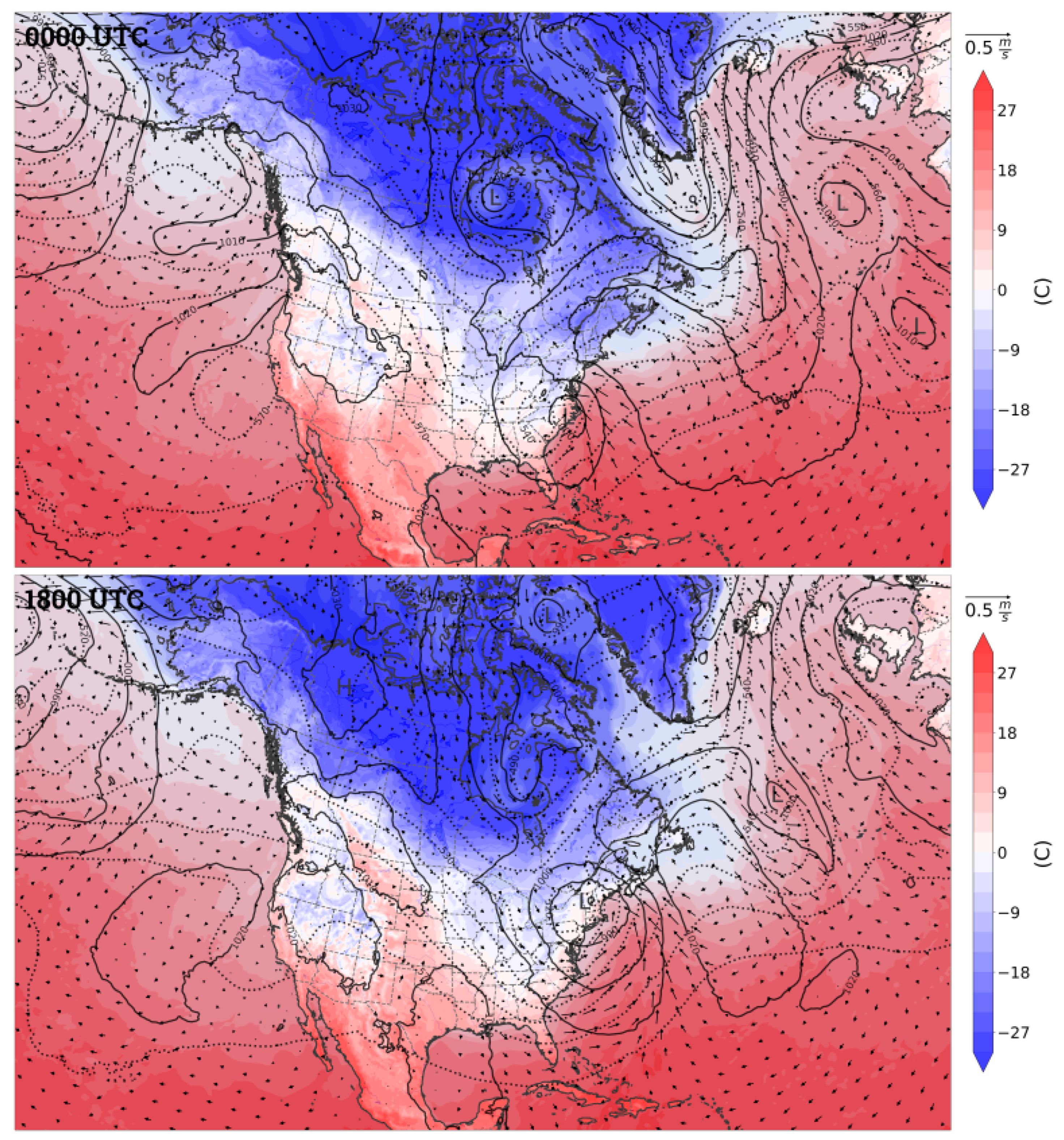
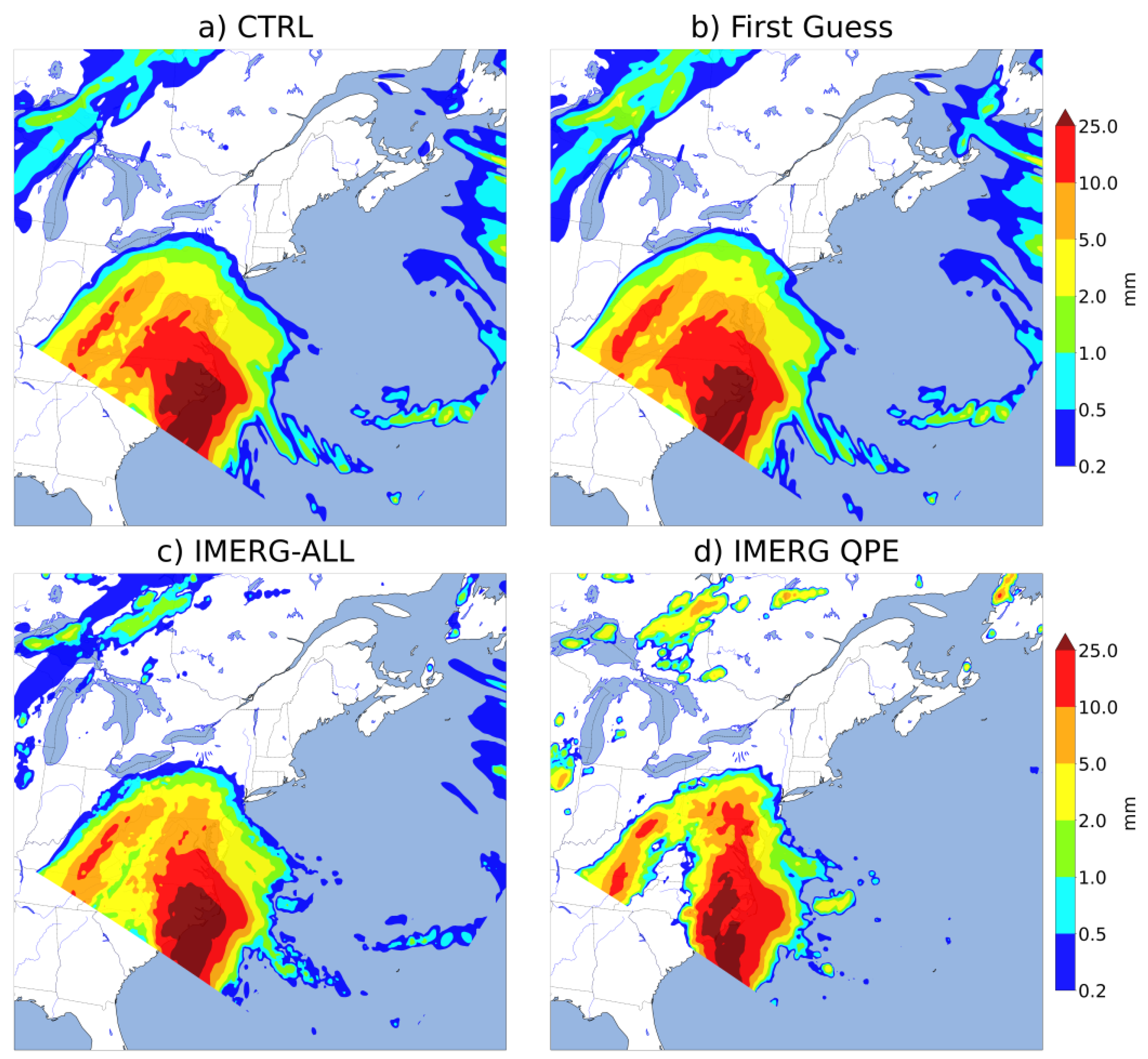

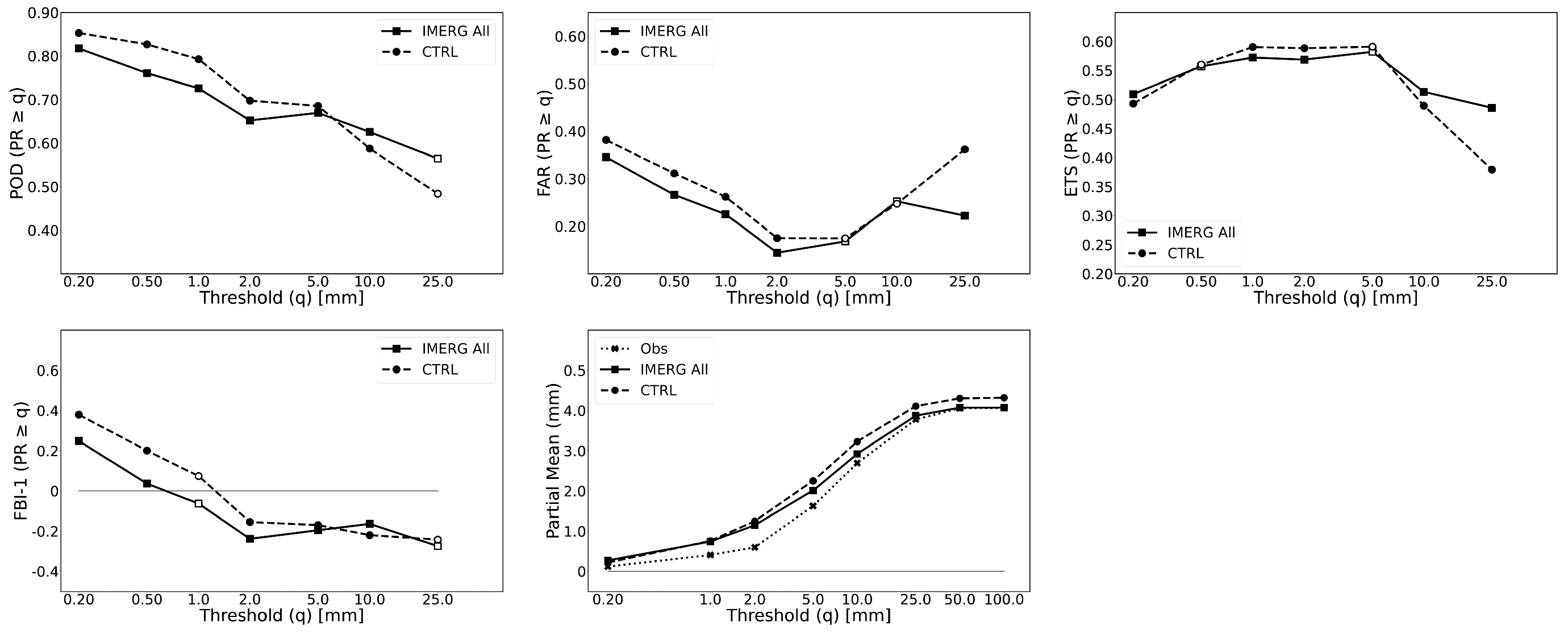

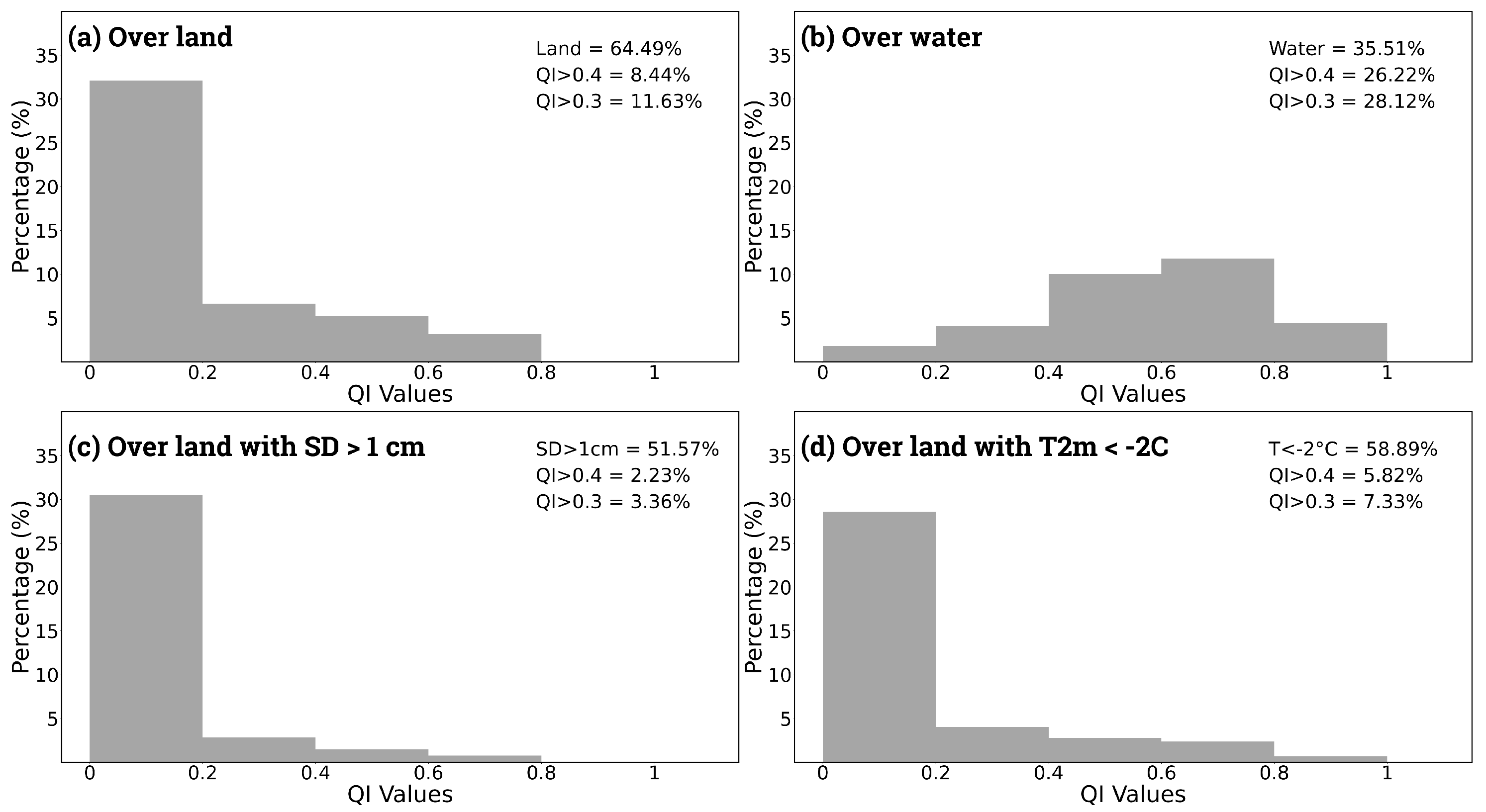
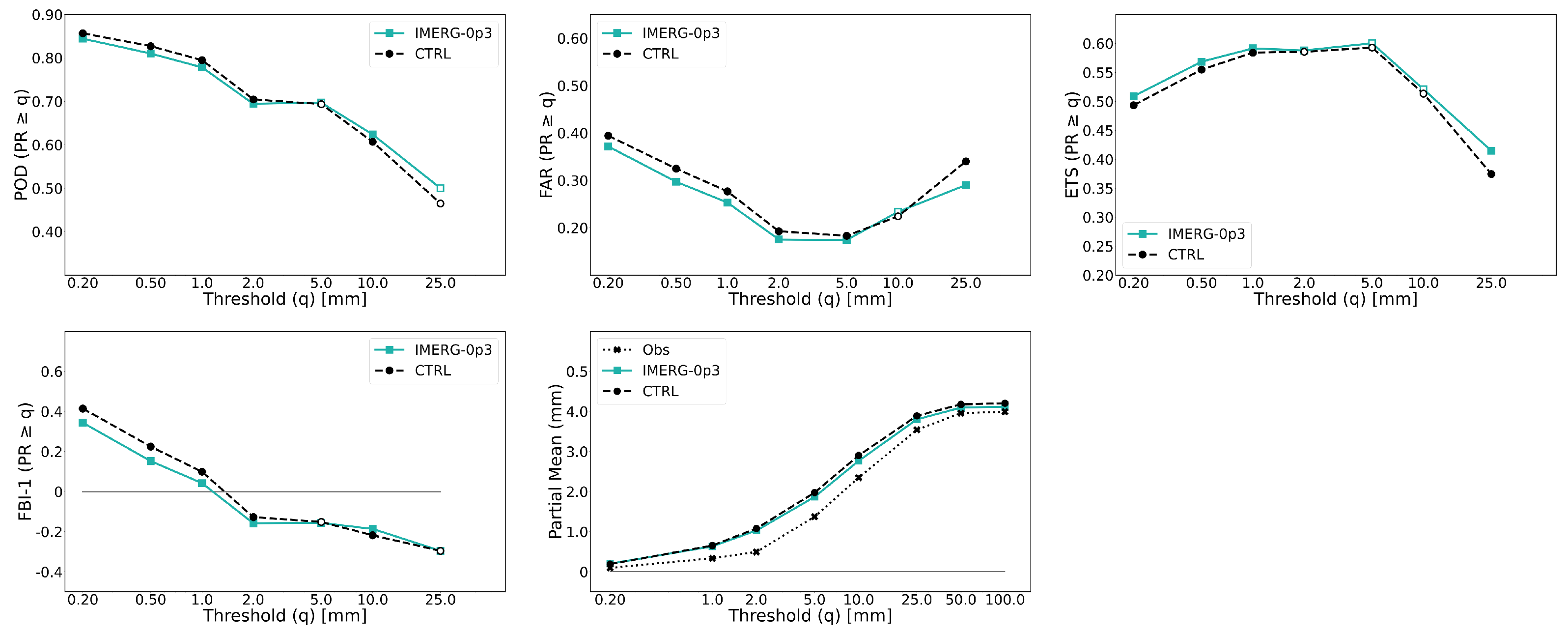
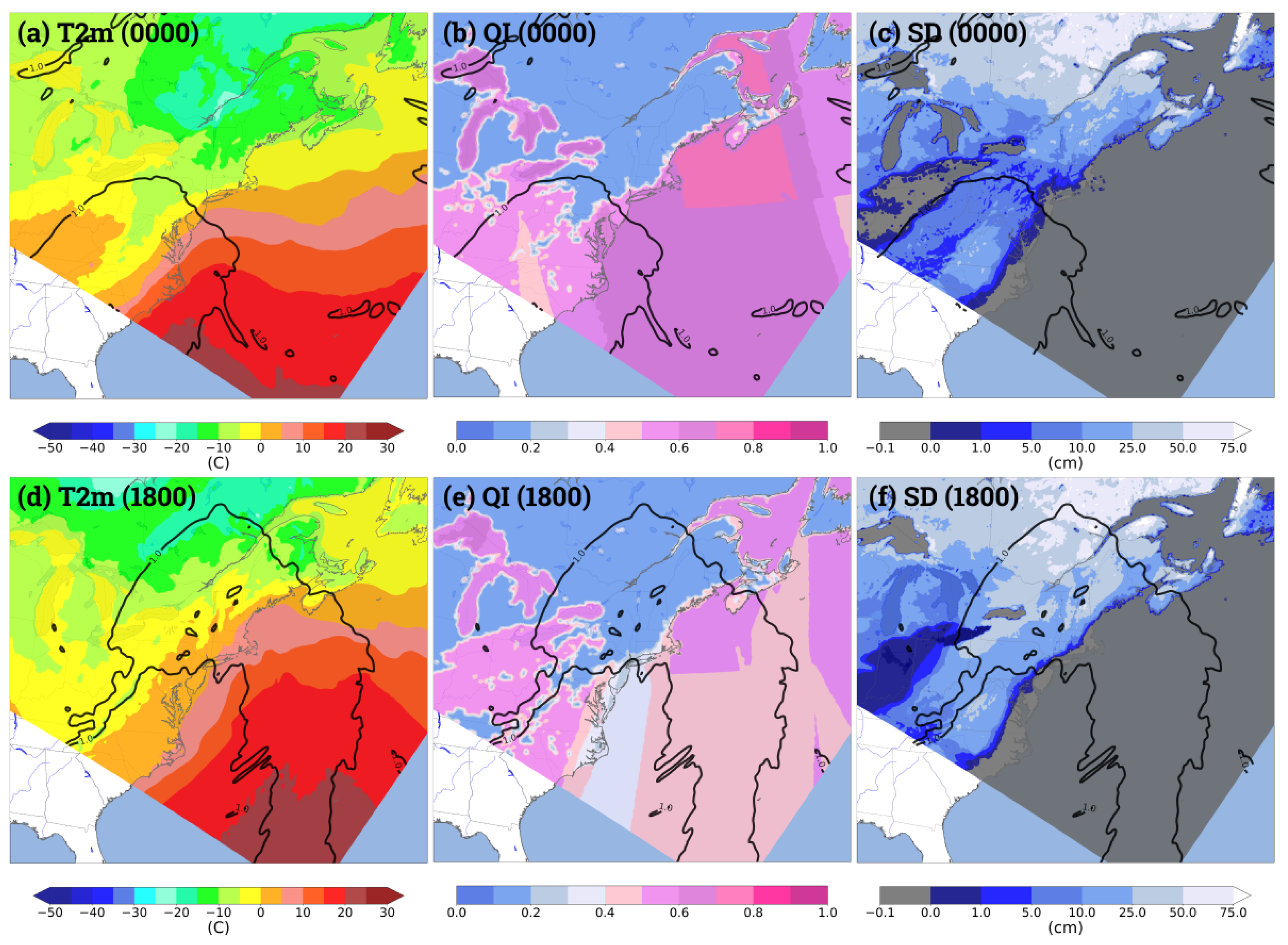
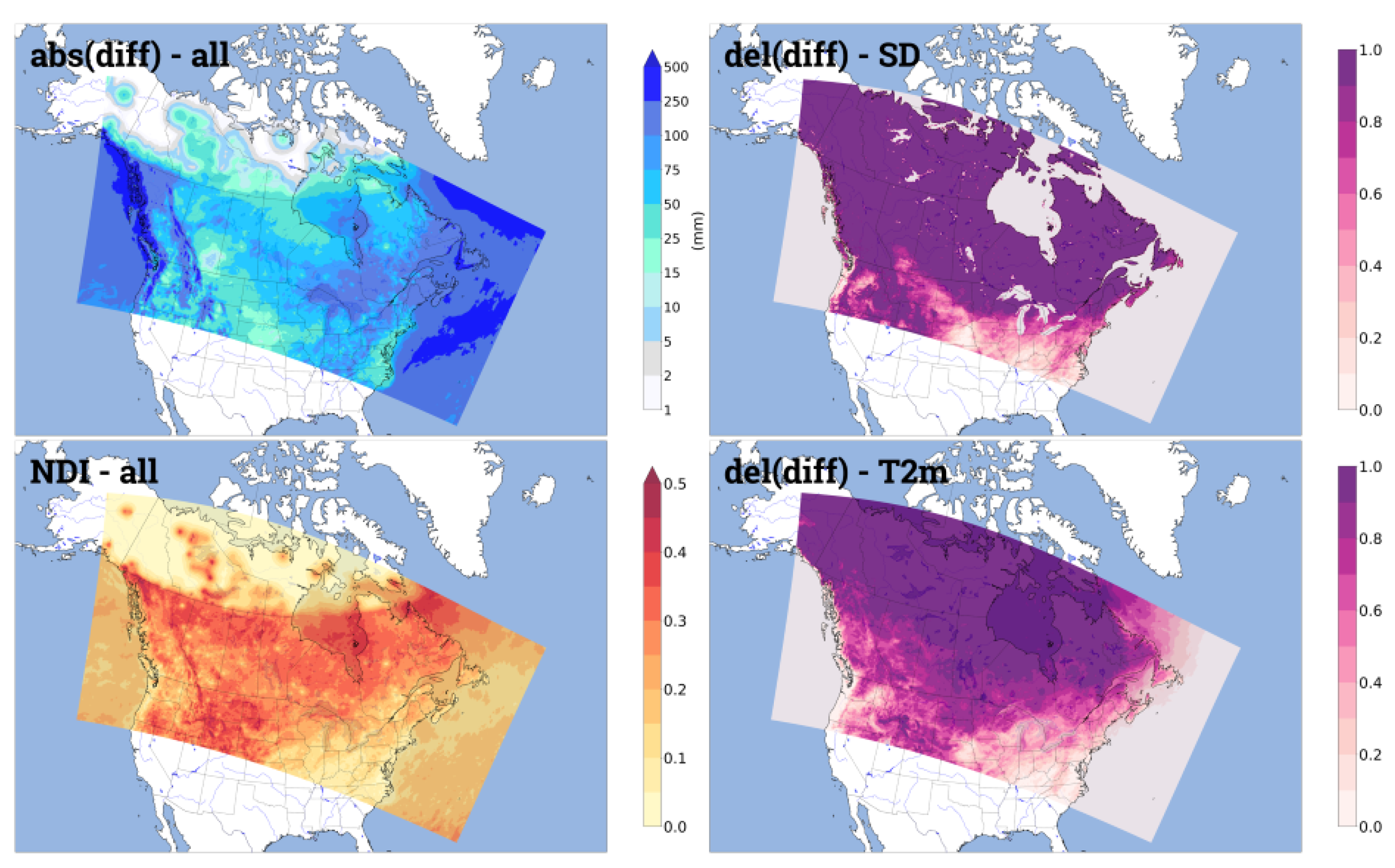

| (mm) | (mm) | (mm) | ||||
|---|---|---|---|---|---|---|
| IMERG-ALL | 0.21 | 0.18 | 0.16 | 73.0 | 58.3 | 44.2 |
| IMERG-0p4 | 0.02 | 0.02 | 0.02 | 11.7 | 7.4 | 5.3 |
| IMERG-0p3 | 0.05 | 0.04 | 0.03 | 22.2 | 14.1 | 10.0 |
Disclaimer/Publisher’s Note: The statements, opinions and data contained in all publications are solely those of the individual author(s) and contributor(s) and not of MDPI and/or the editor(s). MDPI and/or the editor(s) disclaim responsibility for any injury to people or property resulting from any ideas, methods, instructions or products referred to in the content. |
© 2024 by the authors. Licensee MDPI, Basel, Switzerland. This article is an open access article distributed under the terms and conditions of the Creative Commons Attribution (CC BY) license (https://creativecommons.org/licenses/by/4.0/).
Share and Cite
Bélair, S.; Feng, P.-N.; Lespinas, F.; Khedhaouiria, D.; Hudak, D.; Michelson, D.; Aubry, C.; Beaudry, F.; Carrera, M.L.; Thériault, J.M. IMERG in the Canadian Precipitation Analysis (CaPA) System for Winter Applications. Atmosphere 2024, 15, 763. https://doi.org/10.3390/atmos15070763
Bélair S, Feng P-N, Lespinas F, Khedhaouiria D, Hudak D, Michelson D, Aubry C, Beaudry F, Carrera ML, Thériault JM. IMERG in the Canadian Precipitation Analysis (CaPA) System for Winter Applications. Atmosphere. 2024; 15(7):763. https://doi.org/10.3390/atmos15070763
Chicago/Turabian StyleBélair, Stéphane, Pei-Ning Feng, Franck Lespinas, Dikra Khedhaouiria, David Hudak, Daniel Michelson, Catherine Aubry, Florence Beaudry, Marco L. Carrera, and Julie M. Thériault. 2024. "IMERG in the Canadian Precipitation Analysis (CaPA) System for Winter Applications" Atmosphere 15, no. 7: 763. https://doi.org/10.3390/atmos15070763





